A BIRTHDAY SALUTE: The storied DC editor was born 110 years ago, on June 19, 1915…
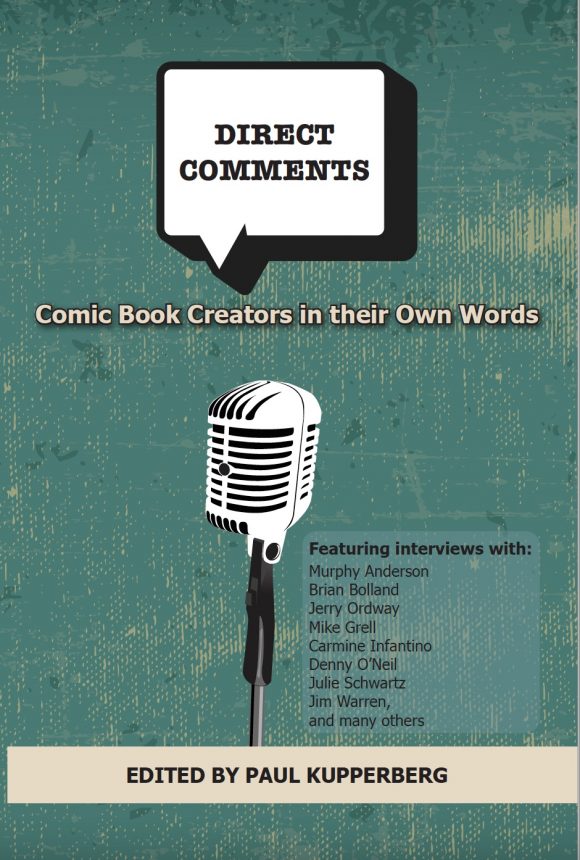
—
UPDATED 6/19/25: This piece first ran on Julius Schwartz’s birthday in 2021, in slightly different form. It holds up just as well today. Dig it. — Dan
—
Paul Kupperberg — comics writer, novelist, historian and 13th Dimension columnist — has a spectacular new publication out: Direct Comments, collecting about two dozen never-completely-published interviews from the ’70s to the ’90s, mostly with some of DC’s greatest creators. We’re talking folks like John Byrne, Denny O’Neil, Jerry Ordway, Jim Aparo, Dick Giordano and many, many more.
You can order the $20 paperback through Amazon — and to spotlight this treasure trove of comics-history gold, we’re kicking off a weekly series in which Paul will pay tribute to his favorite works by 13 of these creators. The series will mostly run weekends through the summer, with a few exceptions, and many installments will be timed to the creators’ birthdays.
Of course, there’s no better place to start than with famed DC editor Julius Schwartz, whose interview is in the book — and who was born 110 years ago on June 19, 1915. — Dan

By PAUL KUPPERBERG
“I told Alfie (Bester) I could see no reason for going down and applying for the job (as editor at All American Comics). I had no qualifications whatsoever. Including that I had never read a comic book in my life. In fact, people in the science fiction community had a name for people who worked in comic books, “squinkas,” a name thought up by Manley Wade Wellman, who was one of my clients. Because, he explained, that when he read a comic book, he sort of had to squink his eyes to read the copy. The funny part is, that although I had never read a comic book, I knew everyone in the science fiction field who was involved in comics. … In any event, I brought a couple of comic books, read them going down on the subway to 25 Lafayette Street, I believe it was. I was interviewed by the editor-in-chief, the only editor there at the time was Sheldon Mayer. He must have been delighted by my abilities and qualifications, so he hired me.”
— Julie Schwartz, from Direct Comments: Comic Book Creators in Their Own Words
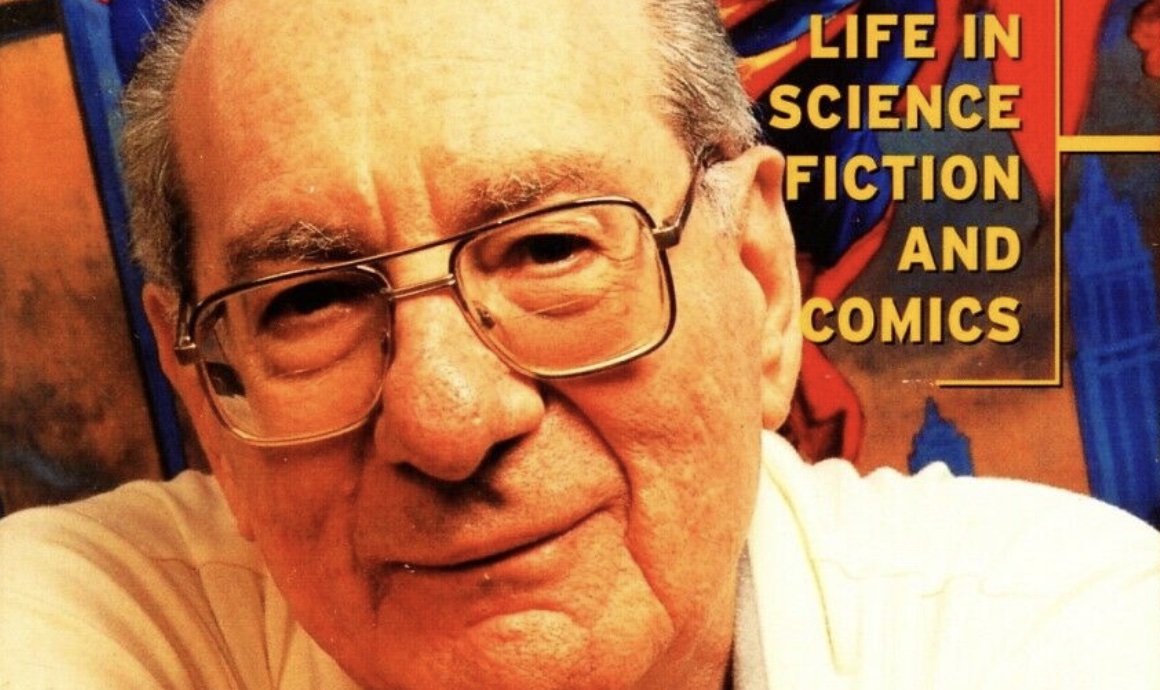
—
In life, Julie Schwartz (June 19, 1915-Feb. 8, 2004) was one in a million, one of the most creative voices in the first half century of comics, and yet he never claimed any skill as a writer or an artist. He was an editor, a “story man” first and foremost, who could take a snippet of an idea or a random scientific fact and run with it until a story emerged.
I discovered the overwhelming force of his imagination the first time I ever sat down with the editor to plot a story in the early 1980s. I had barely spoken the first line of my pitch when Julie grabbed hold and began riffing on it; it took me a few moments to realize I should be taking notes. After a while, a story had emerged — with little help from me, the writer, I’m afraid — and Julie sent me off to write it. Fortunately, as he grew to trust me, I was allowed to (mostly) plot my own stories.

In Direct Comments: Comic Book Creators in Their Own Words, Julie is one of 25 creators who speak about their lives and careers in interviews I conducted between 1989 and 1991 for DC Comics’ monthly newsletter Direct Currents. I only ever used select quotes in the published interviews, and the complete transcripts of only 22 of the 90-plus interviews I conducted survived on an old 3.5-inch floppy disk. (The interviews with Murphy Anderson and Jim Warren were originally conducted in the 1970s for fanzines; the talk with Dick Giordano about submitting proposals to the DC Comics of the 1990s was from a 1993 in-house DC newsletter, Shop Talk.)
But, leaving the shameless plug aside (but not before reminding you that Direct Comments is now available on Amazon!) this column is in celebration of the 106th anniversary of Schwartz’s birth, so please allow me to present to you, MY 13 FAVORITE JULIE SCHWARTZ MOMENTS, in no particular order:
—
Detective Comics #327 (May 1964). Though Julie was already in his 20th year as a DC Comics editor, this was the first book he edited that I experienced in real time and had an impact on me, fresh off the newsstand. ’Tec #327 was famously Schwartz’s first issue as editor of the fading Batman franchise, introducing readers to a “New Look” and, essentially, an old direction (i.e., taking Batman back to his basics as a detective and crimefighter). I had only started reading the title a few months earlier, more for the J’onn J’onzz Martian Manhunter back-up than the adventures of the Caped Crusader. To my great disappointment, Martian Manhunter wasn’t in this issue, replaced by the Elongated Man, but I gambled my 12 cents nonetheless and gave it a try.
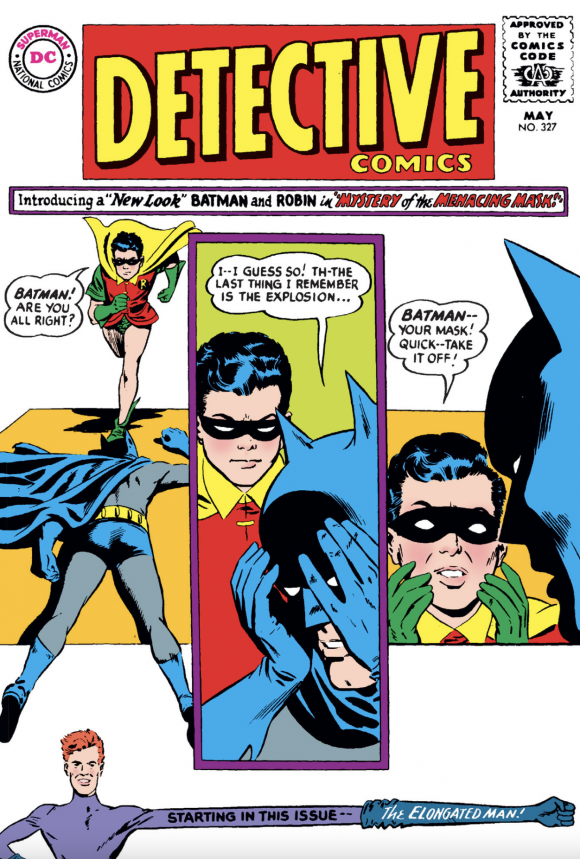
If the downside was losing Martian Manhunter, the upside was the gain of Gardner Fox and Carmine Infantino as replacements for Dave Wood and Sheldon Moldoff on the Batman feature. And, oh yeah, that Elongated Man story (also by Fox and Infantino) was also pretty good.
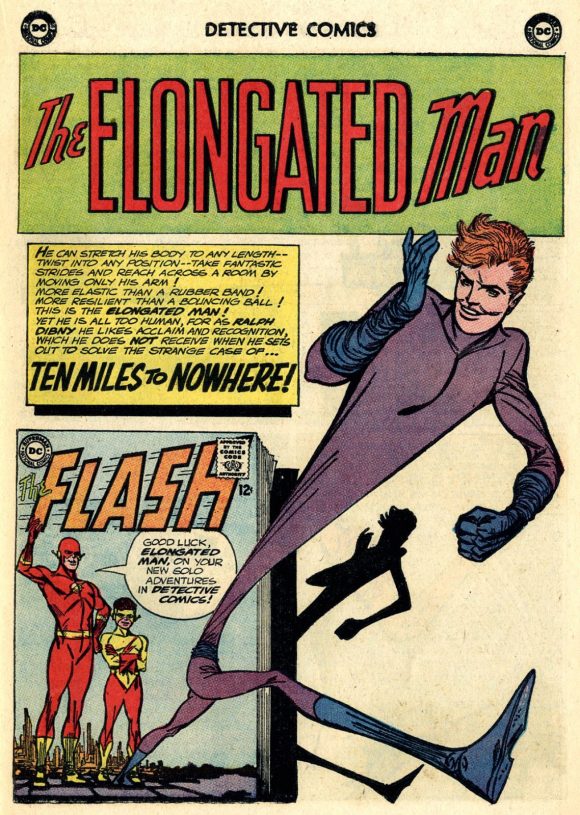
—
The Flash #123 (Sept. 1961). The comic book story that made me a fan for life. Though published in 1961, I didn’t read it until a reprint in the 1965 Flash Annual, after I was already familiar with the Multiverse from the annual JLA/JSA stories and thought the Earth-Two heroes were about the coolest thing I’d ever seen. Then, in “The Flash of Two Worlds,” when I learned that the Multiverse had been discovered on June 14, I was hooked. The Multiverse and I had the same birthday!

Years later, I asked Julie if he remembered how they wound up using June 14 in the story. He wasn’t quite sure and assumed it had been the issue’s shipping or on-sale date, but once the internet came along, I discovered its actual on-sale date had been July 17. The mystery endures, but so does my love for this moment in comics.
—
Showcase #4 (Sept./Oct. 1956). Of course, you can’t talk the Flash and Julie Schwartz without mentioning the key comic book of the Silver Age. Julie remembered the 1955 editorial meeting where the idea of resurrecting the Flash was first floated in (where else?) Direct Comments: “So, Irwin Donenfeld, who was running the outfit at the time, said it sounded like a good idea and wanted to know who was going to edit it. Everyone looked at me because I had been the last editor of the original Flash, so I got the job. … So, after Flash, we did all-new relaunches of Green Lantern in Showcase, and then we did, as I said, Justice League of America in The Brave and the Bold, as well as Hawkman and Atom. And they were all successful.” Yadda yadda yadda…
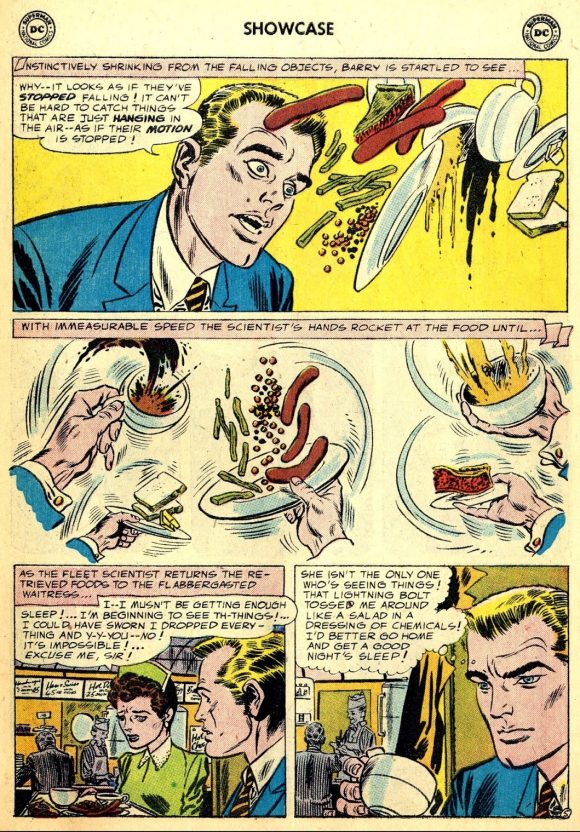
—
The Flash #179 (May 1968). Which brings me to the meta-fictional Julie Schwartz, the version of the man who appeared in the very stories he helped create. One of his most famous fictional appearances was in “The Flash — Fact or Fiction?” by Cary Bates, Ross Andru and Mike Esposito. In it, the Flash is catapulted into a world where everybody recognizes him as a comic book character whose secret identity is Barry Allen.
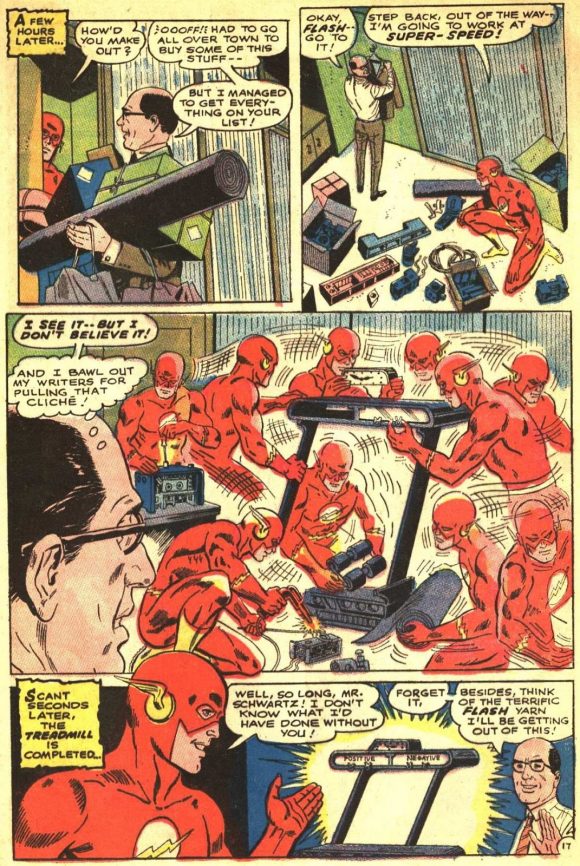
Figuring out he’s on a parallel Earth (which will come to be known as Earth-Prime), the stranded Flash pays a visit to “the one man on this Earth who might believe my fantastic story” — comic book editor Julius Schwartz, at 575 Lexington Ave. in New York.
Julie had a heartbreaking real-world follow-up to his meta-fictional guest-spot, which I shared in a 2012 birthday remembrance on my website, PaulKupperberg.com.
—
Julie Schwartz Cameos (Various). Stand back, Stan Lee — Julie was making cameos long before they were a gleam in the mighty Marvel man’s eye. Julie was a bit of a ham, no doubt about it, so he never objected when artist Sid Greene would slip his mug onto some supporting or background character. Readers of Greene’s science fiction stories in Strange Adventures and Mystery In Space were likely unaware that the slightly bucktooth gentleman passing the main characters in the street was a caricature of the editor, and as Julie once told me, “Sid enjoyed doing it, so I didn’t tell him to stop.” Uh-huh. Sure.
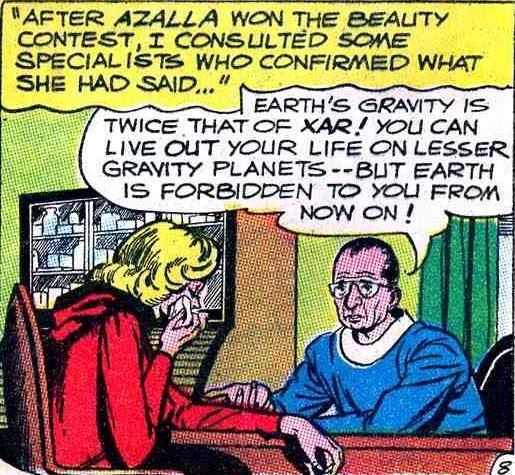
—
Superman #411 (Sept. 1985). This entire issue of Superman was planned and put together behind the editor’s back as a surprise tribute for his 70th birthday. It co-starred Julie in a dual role in a sort of alternate-world “It’s a Wonderful Life.” Then-assistant production manager Todd Klein, who did all the production work on the issue tells the tale of its creation at his blog, strangely called Todd’s Blog.
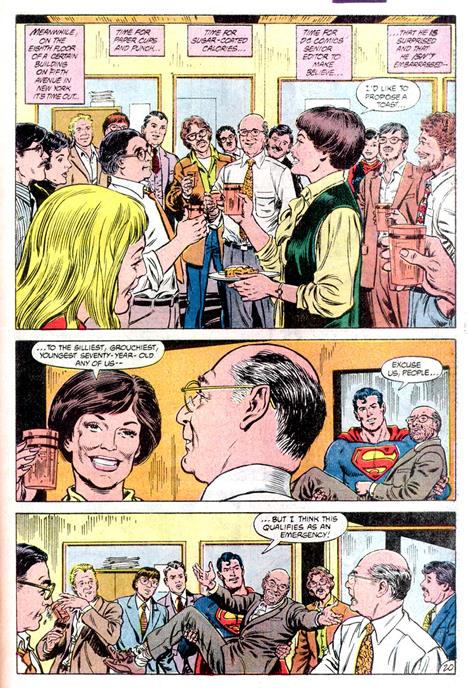
The original art for the cover by Dick Giordano was signed by everybody (I’m right under the “S” in the logo) and presented to Julie.
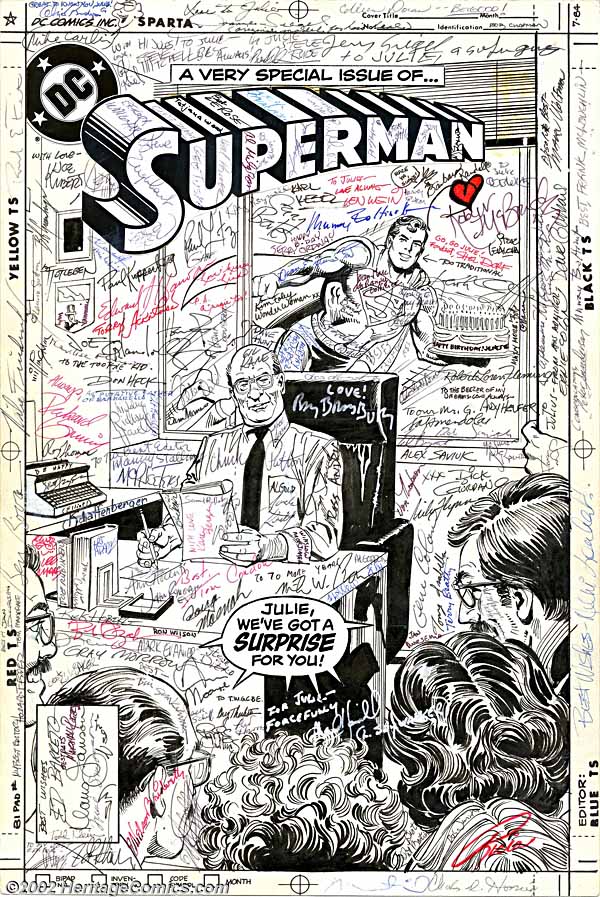
—
Superman #233 (Jan. 1971). A Famous Schwartz First: His debut as editor of Superman, taking over from the retiring (as in stopping work, not being shy) Mort Weisinger after his decades-long reign over the character. Notable for its iconic Neal Adams “Kryptonite Nevermore!” cover, and the “Sand-Superman Saga” by Denny O’Neil, Curt Swan and Murphy Anderson, it continued Julie’s tradition of putting his own personal stamp on the titles and characters he took over.
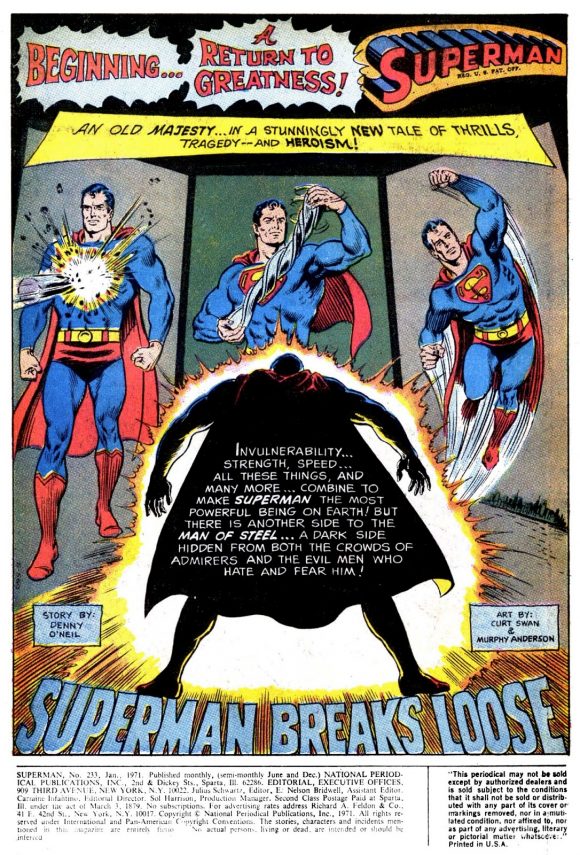
—
Action Comics #419 (Dec. 1972). Another Famous Schwartz First: Julie’s first issue as editor of Action Comics, finally bringing the other marquee Superman title under his control. “The Most Dangerous Man on Earth,” by Bates, Swan and Anderson broke no new ground or differed all that much from a typical Superman issue of the day, but it did have this going for it: the introduction of Len Wein, Infantino and Dick Giordano’s Human Target.
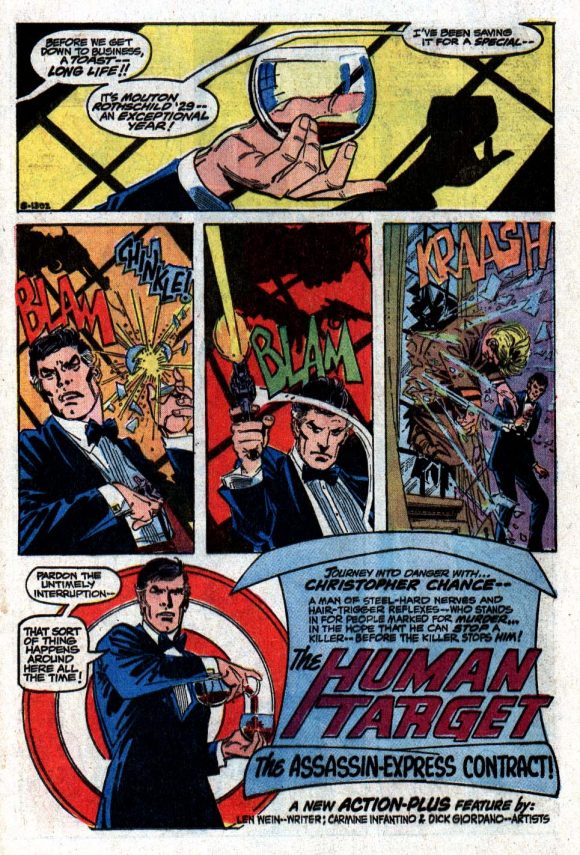
—
Superman #423 (July 1986). After 15 years and the Crisis on Infinite Earths, Julie would hand the caretaking of the Man of Steel to a new editor and creative team. Julie decided to end his time on Superman with a bang, assigning groundbreaking writer Alan Moore to craft “Whatever Happened to the Man of Tomorrow?” — a two-part tale that would not only honor what had come before, but would bring the Schwartz-era Superman and all that had preceded it to a heartwarming conclusion.
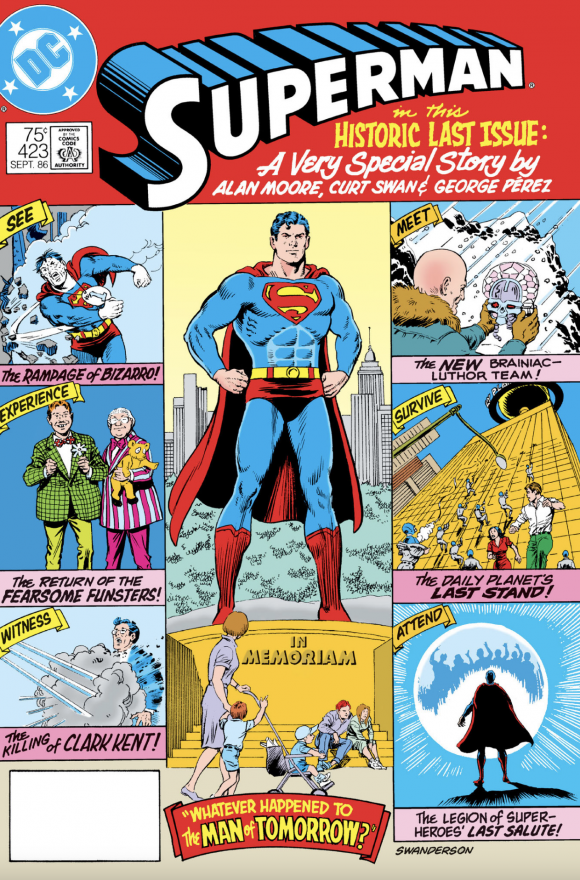
—
Action Comics #583 (Oct. 1986). Julie — along with Superman artist Curt Swan, DC publisher Jenette Kahn, and the heroes of the pre-Crisis DCU — appears on the cover of the “last” Superman story, to bid farewell to the Man of Steel (it was Moore’s Part 2). But for all the story’s nostalgia (and, frankly, high body count of the supporting cast) and the teary-eyed Superman on the cover, Julie’s finale is a winner.
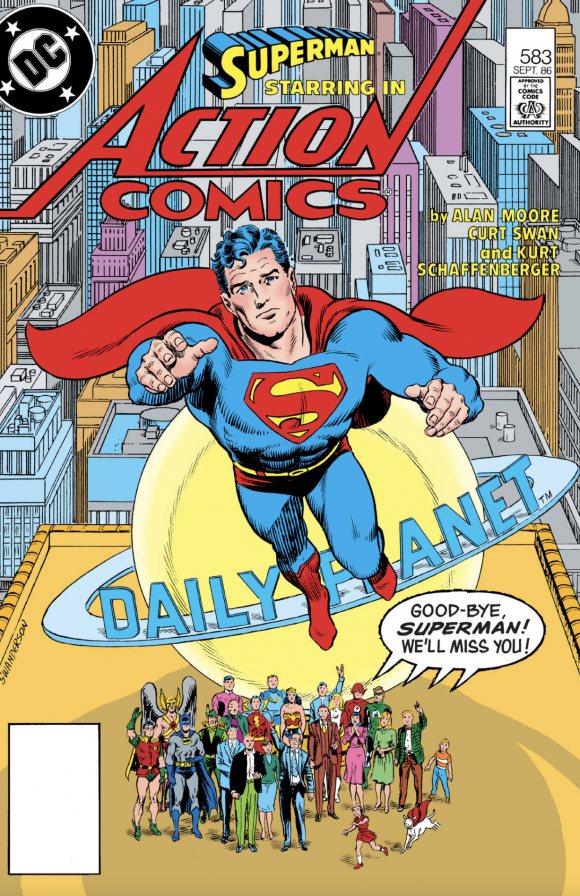
—
“Julie Schwartz Presents 50 Years of Superman” Video Presentation.. Yeah, unless you happened to have attended Chattacon (Chattanooga, Tennessee) in 1988, you’ve probably never even heard of this one, much less seen it.
As he explained in Direct Comments, after he gave up editing, “I became what is known as a consultant. That’s a catch-all phrase for something or other. My main thrust, as Paul Levitz and Dick Giordano tell me, is to be as a goodwill ambassador for DC Comics. I go around to conventions around the country promoting DC. Not only comic book conventions but science fiction as well because many science fiction people are interested in comic books and vice versa.” And it was in his capacity as goodwill ambassador that he gave an hour-long slide presentation celebrating Superman’s 50th anniversary at Chattacon.
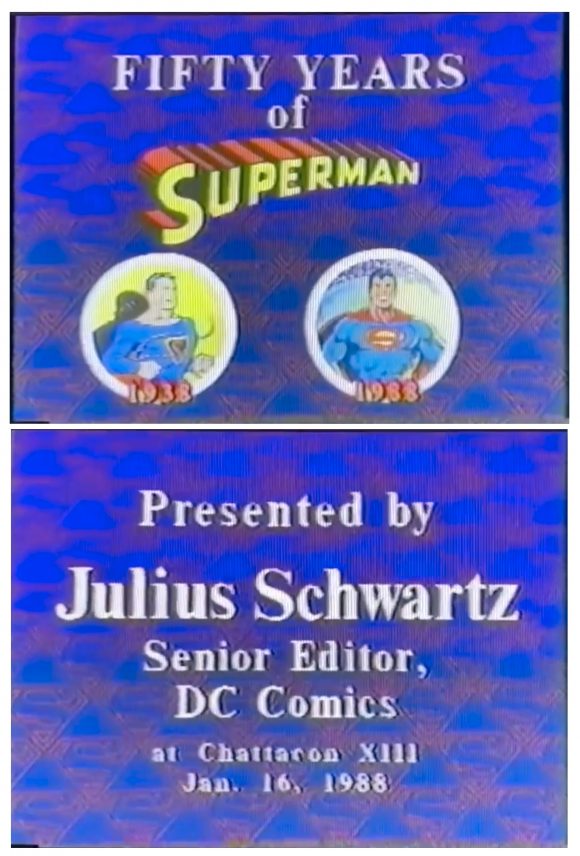
Fortunately, the event was videotaped, and one of the very few copies (I doubt there were more than half-a-dozen dupes made) was given to Julie, who threw in into a file cabinet and forgot about it. Years later, in the 1990s, during the editor emeritus/consultant phase at the end of his career, Julie was slowly cleaning out his office, sorting through things during his weekly Thursday visits to the DC offices.
I made it a point to regularly drop in to say hi and shoot the breeze with my old editor. I would sometimes be there while he was housecleaning, tossing most of what he found directly into the trash… a lot of which I just as quickly salvaged as valued pieces of comics history!
Most of what I saved I turned over to DC’s library (including the 1950s-era science and history books Julie used to mine for interesting facts and plot ideas), but a few mementoes made their way into my collection (gifted to me by Julie, usually with a gruff, “Take it, what do I need to keep this crap for?”), including the 1988 videotape.
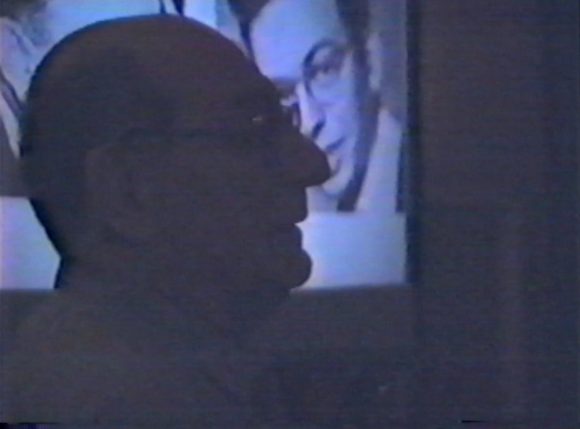
Last year, I found the tape packed away in storage and got someone to transfer the video to digital. While the quality of the second- or third-generation dub isn’t the best and the sound is somewhat sketchy, it provides the only record of Julie’s slide show presentation about the origins and history of Superman; as far as I’ve been able to ascertain, Chattanooga might have been the only time he delivered this talk (and please, if you know otherwise, let me know!). And hearin’ dat Bronx accent again makes me smile.
Plans last year to do some sort of online world premiere of the video (followed by putting it up on YouTube) never came to fruition. I need to get back on that…
—
Man of Two Worlds (2000), Harper Paperbacks. Julie Schwartz — unplugged! Sorta. As happy as I am that Julie left behind a first-person record of his life, he didn’t quite tell the whole tale, leaving out a lot of stories he would tell in person that weren’t always flattering to himself or others. As a result, Man of Two Worlds (written with Brian Thomsen) — the title refers to “The Flash of Two Worlds” and his careers in the worlds of science fiction and comics — is an easy memoir that skims the surface of his accomplishments and the people he’d known.
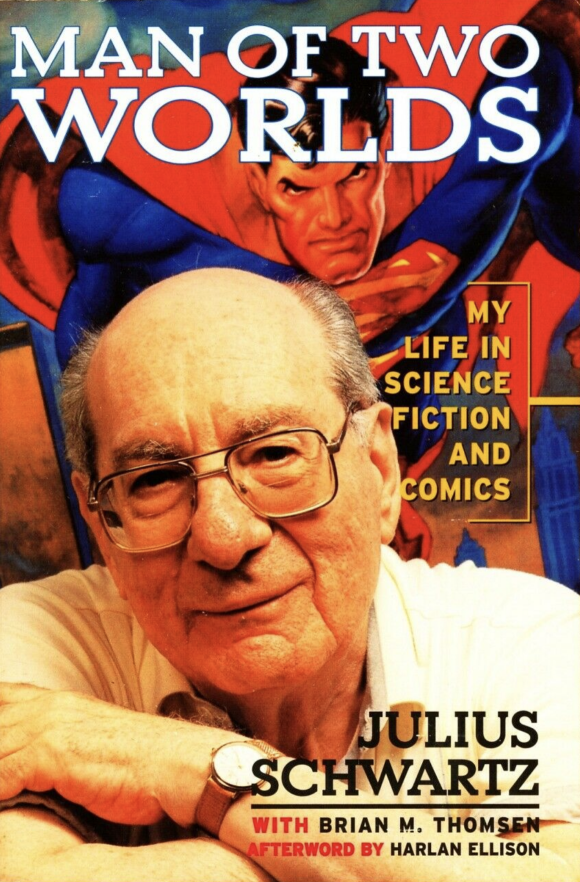
Julie had been working on the book for several years, originally with Elliot Maggin, who eventually had to bow out of the project. In the 1990s, he asked if I would be interested in working with him on it but, frankly, I chickened out, a bit overwhelmed by both the subject matter and my own inexperience writing prose. There’s no telling if I could have done any better than Brian in convincing Julie to include some of his meatier experiences and express some of his less than positive opinions, but I regret not having tried. ’Cause Julie really unplugged would have made for a hell of a read.
—
Absolute Favorite Julie Schwartz Moment. The moment when he first gave me the chance to fulfill my dream to write Superman comics for Julie Schwartz, the greatest editor of all time, followed by the gift of his confidence, and, finally, his friendship. Happy birthday, Julie!
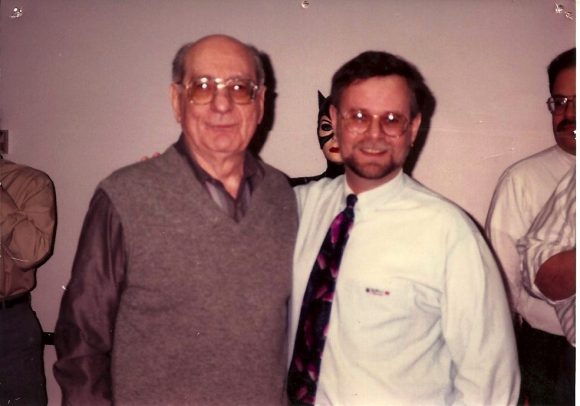
Later, Schwartz!
—
NEXT: What do I like about Jerry Ordway’s comics? Lots of stuff! (Click here.)

“I showed (my samples) to Joe Orlando, but he was kind of burned out by then, having spent days looking at samples, there were just so many people. Then Paul Levitz came by, looked down at the work, and just totally floored me. He looked up and said, ‘Oh, Jerry Ordway. We’ve been trying to get a hold of you.’ He took my number, I went home, and started getting scripts for stories for Weird War Tales and things like that.”
—Jerry Ordway
—
MORE
— The Complete INDEX of DIRECT COMMENTS Features. Click here.
— THE ATLAS OF THE DC UNIVERSE: Paul Kupperberg Reveals 13 FASCINATING FACTS. Click here.
—
Direct Comments is available now at Amazon. Click here.
—
Paul Kupperberg has been writing comic books from Archie to Zatanna for 45 years at DC, Archie, Charlton, Marvel, Bongo and others. He is also the author of Paul Kupperberg’s Illustrated Guide to Writing Comics (Charlton Neo Press); I Never Write for the Money… But I Always Turn in the Manuscript for a Check (Comics Career); the comic book industry-based murder mystery The Same Old Story, the short-story collection In My Shorts: Hitler’s Bellhop and Other Stories, JSA: Ragnarok, and his latest, the YA fantasy/time travel adventure Emma’s Landing, all from Crazy 8 Press and all available on Amazon, or signed and personalized direct from Paul (email him at pkupps55@yahoo.com for details).

June 19, 2021
I really enjoyed this. Look forward to reading the book! I can almost hear his voice as I read the article. Thank you!
June 20, 2021
I got to meet him when I was 30. I was blessed to tell him and Murphy Anderson how much joy their work gave me.
Julie said, “You’re the youngest guy at this pulp convention, Jimmy, but if you go to a comics convention you’ll be one of the older guys in the room.” Next summer I found out he was right.
June 19, 2022
Great article, Paul! Please do get that video up on YouTube!
June 26, 2022
Have you ever been asked the question “If you could have dinner with anyone alive or dead, who would it be and why?” While everyone says something smart like Gandhi or Gore Vidal. I always say “Julie Schwartz” After the inevitable “Who’s She?” I answer the “why?” part of the question. “Because a day without comics is like a day without Doris.”
My favorite cameo of his has to be when “Julie Lad” told the Legion of Super Heroes “If he’s (Ambush Bug) bothering you, I’ll gladly get rid of him.” A sly joke about editorial power, I’m sure,
June 19, 2024
Paul, the video…. did you ever put it up on YouTube?
June 21, 2024
Some of the more eclectic signatures on that Superman cover… the reclusive Alan Moore, and Steve Ditko, Marvel’s Jim Shooter, Mark Hammil, Samuel R. Delany, Jack Kirby, and of course, Ray Bradbury.
June 19, 2025
The Swanderson team (Curt Swan and Murphy Anderson) introduced me to Superman before I could even read. I loved their depiction of the man of steel.
June 19, 2025
A lot of examples of his work here are very Meta, from Stories that feature him to characters commentating on editorial decisions- such as the Elongated Man leaving for a different comic!
June 20, 2025
Gonna answer my own question from last year…. But, I found “a” version of the presentation. Maybe Paul has a different one to share…. https://www.youtube.com/watch?v=fOskpETTU_o